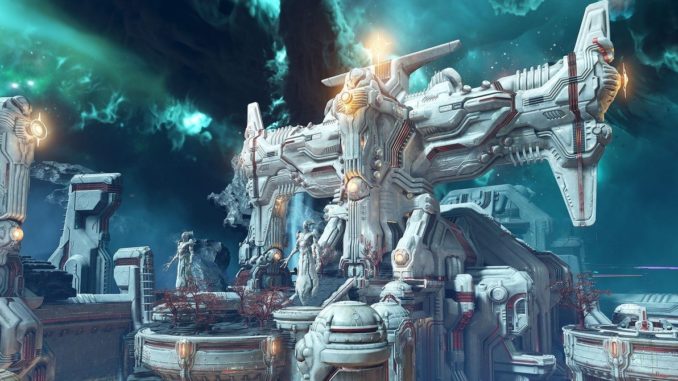
Demonic blood, brutality, and speed. When Doom rebooted itself in 2016, resurrecting one of gaming’s oldest franchises into the modern era, it built a new, airtight formula for itself. It was a set of ideas that emphasized speed and intimacy in combat, rewarding you for your daring with more health, more ammunition, and more excitement. Then, all of that excitement was wrapped up in pulpy, pastiche aesthetics—a big hero with big guns who hates demons and wants to tear out their big guts. All told, it’s simple, immediately satisfying, and perfectly suited for a sequel.
Doom Eternal is that sequel, and it immediately sets to work upping the ante. Instead of Mars, it’s the entirety of human civilization that is under siege by demons from hell. There are more enemies, more weapons, more elements in the sandbox of combat. And the story has gone full maximalist, a Heavy Metal short that spans 15 hours. It’s immense, messy, and, unfortunately, not nearly as good as the original.
Doom Eternal, which comes out Friday for PC, PlayStation 4, Xbox One, and Google Stadia, begins with a disorienting immediacy. As the Doom Slayer—a mythic hunter of demons, shotgun always in hand—you’re hunting down a hell priest in a fortress above a ruined, monster-infested Earth. He’s part of a triumvirate that, if not stopped, will usher in the complete destruction of the planet. Which is an early indication of the problems at the core of Doom Eternal: hell priests? Who? What? It feels like immediate whiplash, as if you’ve been thrust into a story that’s already half over with no clear indication of how you arrived. For those who were interested in the story of the last game and would like to connect the two, it plays as though several chapters have been skipped. Once ensconced, the plot doesn’t get much better. It bounces around dimensions rapidly and key narrative information is often conveyed through overwrought lore entries. It’s dizzying.
Not that story has ever been the most important factor in a Doom game. But it’s an underrated factor in why 2016’s reboot worked so well. It was not, all told, an exceptionally clever or original story. Its minimal characters weren’t exceptionally interesting; the conceit, of an energy company mining hell itself for power, is both too on-the-nose and, somehow, in the era of climate change, not on-the-nose enough. But it was a story exceptionally well told. Here you were, a silent avatar of rage, but held under lock and key by an amoral energy company and forced to fight demons, not just for the joy of fighting demons, but to combat an invasion caused by someone else’s incompetence and greed. The game excelled at tiny moments of characterization and mood that gave flavor to the action: the Doom Slayer, casually breaking the energy company’s things and ignoring the man in charge. The deranged corporate messaging from the company itself, which slowly devolved from standard pablum to the demented ravings of a death cult.
That’s what made Doom so special in 2016: not just that it was a thrilling action game, but that it felt like a clever, often funny descent into hell by way of corporate greed and irresponsibility. It was the perfect game for being mad at your boss. Doom Eternal, by way of contrast, pushes the personality of the first game to its breaking point, with little added on top of it. The esoteric liner-notes lore about hell and demons that served as flavor in the original game were there but not to be taken too seriously; unfortunately, they are the center point of the sequel’s narrative design. Instead of telling an immediate, straightforward story well, it tells a broader, more convoluted story poorly, and in the process squanders much of the charm of the original that made the gory demon-killing feel so vital. This trickles down from the actual writing to the places you go, and the explanations for going to them. Without an underlying level of wit, little of it lands.
Here’s the thing: Contrary to its over-the-top appearance, what made Doom 2016 such a good game was its restraint. Its narrative restraint gave it personality, and its mechanical restraint—focusing the combat on a handful of key elements—made the fast, frantic action work. The gameplay was balanced around a sort of rock-paper-scissors. Demons try to kill you, and you shoot them with a variety of weapons. When they get weak, they flash, and you can get in close to initiate a special finishing move, a “glory kill,” that restores your health. If you run out of ammo, killing an enemy with the Doom Slayer’s chain saw will give you some. That means that there’s a straightforward solution to every possible problem encountered in Doom: If you’re hurt, glory kill; if you’re low on supplies, chain saw; otherwise, keep fighting. Repeat until the only thing left moving is you.
